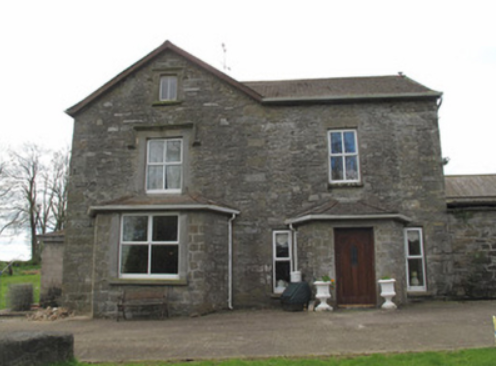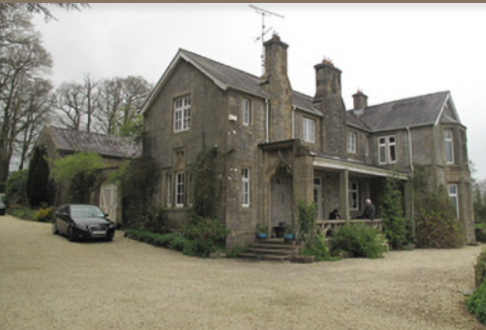Carrachor
Houses within 5km of this house
Displaying 12 houses.
Houses within 5km of Carrachor
Displaying 12 houses.
| House name | Description | |
|---|---|---|
| Gola | Built in 1703 by Joseph Wright son of James Wright and his second wife Mary Slacke (www.thesilverbowl.com). It was the home of the Wright later Woodwright family in the 18th and 19th centuries. At the time of Griffith’s Valuation the Reverend William E. H. Woodwright was resident. The buildings were valued at £25. In 1901, Patrick Callaghan, steward, was resident in Gola. Sir John Banks (1815-1908) was the proprietor. He was a well-known Dublin physican who had married in 1848 Alice Woodwright. Their only child Mary married Willoughby Burrell 4th Baron Gwydyr in 1873. On 25 February 1921 Gola was burnt and subsequently demolished. | |
| Clonamully | This house, sometimes spelt Clenamully, was the home of the Fiddes family in the 19th century. Members of the Fiddes family were land agents. Located on the Lewis, formerly Scott estate, it was named on the 1st edition 6 inch Ordnance Survey map (1836) and had a walled garden. The Reverend James Fiddes was rector of the parish of Drumsnat. Edward Fiddes who inhabited the house in the 1830s and at the time of Griffith’s Valuation was the Reverend James’ son and agent to the Rose estate. Edward died in 1868, aged 78, and was buried in Drumsnat graveyard. In 1901, Joseph Fiddes, land agent, was the occupier and in 1911 four of his children were living in the house. The original house has had additions and alterations. |

|
| Mullaghmore | This was the home of James Rose and after his death in 1841 of his niece Gertrude. It was described by Lewis in the 1830s as ‘greatly improved and extensively planted’. The buildings were valued at £38 at the time of Griffith’s Valuation circa 1860 but the house was unoccupied at the time. Gertrude Rose was, however, resident in 1901. Home of Sir Robert Anderson, Mayor of Belfast 1908, for a few years; his widow was living at Mullaghmore in 1911. The house was later the home of a Captain Taft and was destroyed by a fire in 1925 (New Zealand Tablet, 8 April 1925, 47). |

|
| Slacksgrove/Hollywood House | Slacksgrove is marked as a long building close to the shore of Slacksgrove Lake on the 1st edition 6 inch Ordnance Survey map (1836). It was named after the family who lived there in the 18th century. John Slack of Slacksgrove was High Sheriff of county Monaghan in 1758. Lewis records R. Jackson as resident at Slacke’s Grove in the 1830s. A later square house on the same site, known as Hollywood House, was built before Griffith’s Valuation of the mid-19th century. This house with an extensive farmyard was valued at £36. It was occupied by James Fiddes who held the property from Thomas Coote. Edward Fiddes and his daughter lived in the house in the early 20th century. Only the outbuildings of Hollywood House still remain. | |
| Mont Louise | Home of the Evatt family in the 19th century, R. Evatt was resident in the 1830s. Samuel Evatt was the occupier circa 1860. He held the property in fee and the buildings were valued at £9. Home of George F. Evatt at the beginning of the 20th century. A building is still located at this site. | |
| Drumreask | Built circa 1840 for Alexander Mitchell, agent to the Shirley estate. This house was the home of the Mitchell family until sold in 1864 to the Kane family. It is named on the 1st edition 6 inch Ordnance Survey map (1836) with an extensive walled garden at the rear. Griffith’s Valuation records the value of the buildings at £25 held by Henry Mitchell in fee. It was still in the ownership of the Kane family in the early 20th century. The house was derelict in the early 21st century. It was purchased by millionaire Gerry McCaughey with a view to turning it into a hotel and equestrian centre (Irish Independent, 25 May 2008) but this does not seem to have come to fruition. |

|
| Selloo | A building at this site is marked on the 1st edition Ordnance Survey map (1836) and named on the 25 inch map. In 1853 Selloo described as a 'convenient residence, placed in an ornamentally planted demesne, and also a corn mill, kiln etc' was advertised for sale in the Encumbered Estates Court by Joseph Whitsitt. This was the home of the Pringle family in the mid-19th century, valued at £18 and held in fee by William Pringle. The Hunter and Deering families occupied the house in 1901 and 1911 while Thomas A. Pringle was the landholder. It appears to be currently extant. | |
| Cappog House | A house built in the mid-19th century, valued at £10 circa 1860 and occupied by Richard Blakely and held from Henry Mitchell. In the early 20th century home of Ernest Henry Greene, a distinguished Irish tennis player & his wife Georgiana, a painter. This house appears to be still extant. | |
| Clontoe | A house valued at £7 occupied and held in fee by John Wright at the time of Griffith’s Valuation (circa 1860). Still in the possession of the representatives of J. Wright at the beginning of the 20th century, it was occupied by the Humphries family. | |
| Lisdoogan | A small building marked at this site on the 1st edition 6 inch Ordnance Survey map (1836). It was valued at £8 in the mid-19th century and John Stephenson was the occupier holding the property from Henry Mitchell. The building was enlarged at about this time and again circa 1900 to create the substantial building of today. James Mitchell, formerly Clerk of the Union, and his family were resident at the beginning of the 20th century. |

|
| Tullaghan | The ruins of Tullaghan House are marked on the 1st edition 6 inch Ordnance Survey map (1836). It was located on the estate of Lord Rossmore. Lewis writes in the 1830s that Tullaghan belonged to the Reverend Sir Thomas Forster Bart. ‘whose family formally resided here’. By the time of Griffith’s Valuation a herd’s house had been erected close by. It is named Tullaghan House on the 25 inch map (surveyed 1908). | |
| Riversdale (Tedavnet) | This house is marked on the 1st edition 6 inch Ordnance Survey map (1836) and on the 25 inch map (surveyed 1908) it is named. It was located on the outskirts of the village of Bellanode, close to the River Blackwater and to a number of mills. Occupied by Thomas Wright in the mid-19th century and held from Henry Mitchell, the buildings were valued at £6.10.0. A building is still extant at this site. |

